To say that deer have been a challenge over the years is somewhat of an understatement. Deer love to graze around my garden. In fact over the last couple months we’ve watched as a family of deer has grown. Several fawns appeared in the garden and have been growing like the weeds. Gardeners and deer can coexist but as a gardener you have to use a variety of tricks to protect the plants you love.
(Some affiliate links to helpful products have been included in this post.)
Deer Fences
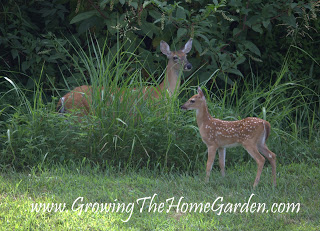
The MOST effect strategy for keeping deer away from your plants is to put up a fence. Deer can jump high so most people recommend installing a deer fence at 10 feet tall. We fenced in our vegetable garden area by using 4×4 pressure treated posts and wire mesh fencing but only put it at about 6 and a half feet. That has been enough to keep our deer population of eating all my tomatoes. Deer are habitual grazers so if you can break the habit of where they like to eat they will change course and go toward easier to reach food sources.
Deer Repellents
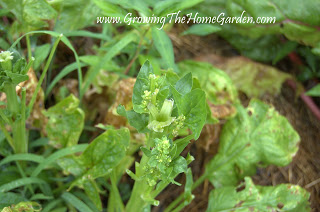
Deer repellent is probably the second most effective method at deterring deer. There’s a variety of sprays available to use. Deer sprays apply directly to your plants that are vulnerable to deer. As the deer graze the smell/taste turns the deer off and they leave the plants alone in favor of something better. The downside is you have to reapply repellents after rains because they wash away. If you add this in to your garden routine you can effectively protect your plants against deer grazing. Deer Out is one of the more popular products and has some wash off resistance.
Some repellents use predator urine to scare away the deer and keep them out of the home garden. Don’t ask me how they collect it! You spray it in areas where deer go and when they catch the scent they turn away and go another direction. I’m not sure how effective these repellents are as I’ve never used them but the science makes sense.
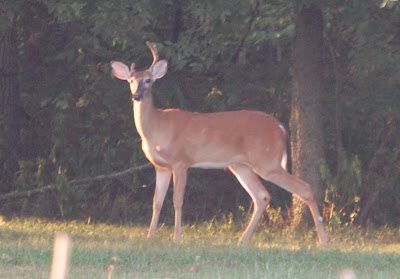
I have also sprinkled blood meal in random locations. It’s a nitrogen rich fertilizer but it leaves the scent of blood in some areas that the deer can detect. The idea is to scare off the deer when they think a predator might be lurking in the area after a fresh kill. This works some but needs repeated applications as the rain will wash it away.
Deer Tolerant Plants
There are many plants that are deer resistant. These plants have textures, scents, or just aren’t edible and the deer avoid these plants. If you plant deer resistant plants in areas prone to deer grazing you will help reduce the overall damage to your garden. If the area doesn’t seem to be as palatable the deer may eventually wander to other areas. Try interplanting deer resistant species of plants with your garden favorites that are more prone to deer grazing and you may be able to confuse the deer a bit! You should also consider using a deer repellent on those more vulnerable plants to take away the salad bar completely.
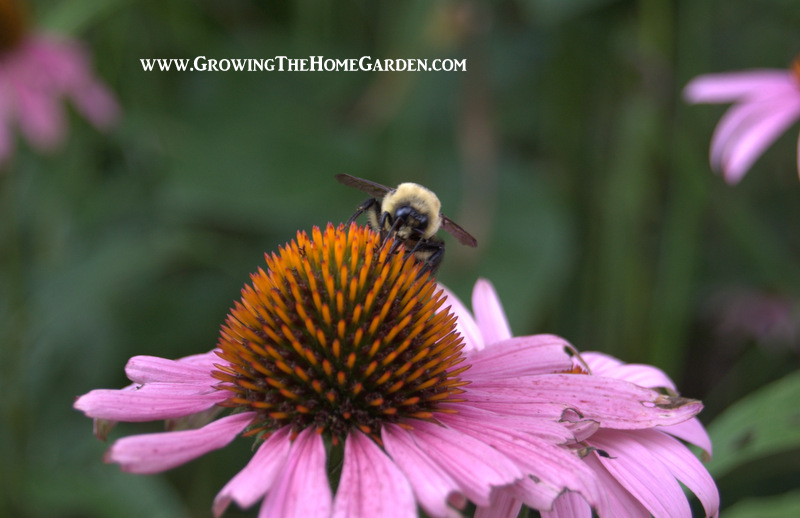
Deer Tolerant Plants
- Lavender (Lavandula)
- Russian Sage (Perovskia atriplicifolia)
- Salvia (Salvia spp.)
- Hellebore (Helleborus)
- Caryopteris
- Bee Balm (Monarda)
- Yarrow (Achillea millefolium)
- Daffodils (Narcissus spp.)
- Bleeding Heart (Dicentra spp.)
- Fountain Grass (Pennisetum spp.)
- Coneflowers (Echinacea spp.)
- Boxwood (Buxus)
While planting deer tolerant or resistant plants is a great idea it isn’t always effective. I’ve tried this by interplanting hellebore with my hostas. It worked very well for several years but eventually the deer found the hostas and chowed down! I still strongly recommend this method of protecting plants from deer but it does need to be combined repellents.
Deer Prevention Devices
Radios
There are a number of devices designed to scare deer away but I haven’t used many of them. I’ve always wanted to try hooking up a motion sensor to a radio set to a talk radio station to try to frighten them off. The idea is to scare them with human voices.
Simulating Predator Eyes
I’ve also heard where setting up a pair of red lights in the garden set to motion sensors makes them think a predator is looking at them. There are some products that simulate predator eyes that may work but again I haven’t tried them. Since deer are red and green color blind I think it’s more the light itself rather than the color that matters. I think in order for them to be effective these devices would need to be moved around periodically so the deer did not get used to them.
Motion Sensor Sprayers
I tried using a sprayer on a motion sensor once. It worked by turning on when movement was detected. It leaked a little at the unit and we had a leaky faucet the house and I didn’t want to leave it connected.
Pets
If you happen to have a dog they make great deer repellents! They will keep the deer away while out in the yard but when the dog isn’t outside the deer may take advantage of the unprotected garden. If you are able to adopt a new pet it may just benefit you in the garden as well as becoming a new family member!
Prevent Deer Rubbing
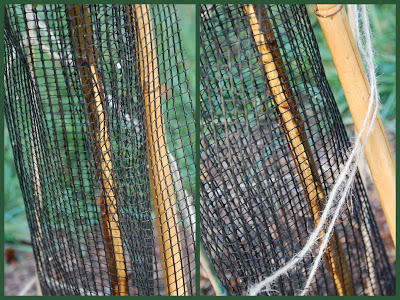
In the fall and early winter deer will rub off the fuzz from their antlers. They use smaller sized tree for this that can easily be damaged. I learned about this years ago when they killed a tree by removing all the bark around the trunk! Since then when I plant younger trees I wrap a plastic mesh around it until the tree is old enough to survive a little damage every now and then. There are plenty of trees around for the deer to rub, I just don’t want them on my plants!
My Recommendations for Gardening with the Deer
Overall I think you need to use a combination of methods. Nothing will work 100% except for a completely enclosed fence area. Fences aren’t always practical though. They can be expensive and requires some labor to put together. Deer are habitual grazers and if you can disrupt their habit to get them on a new path you can control the damage to some extent.
Homemade Plant Tags for Hybridizing Plants
Last year I began to experiment with hybridizing. I’m hoping that the plants I cross together result in something really nice but it takes a few years to get something from the crosses. So far I’ve experimented with daylilies, echinacea, and irises. Hostas are on my list but the deer keep getting to the flowers before they’ve had a chance…
The New Southern Living Garden Book – Review!
Great garden books are an awesome resource for any gardener. They become a reference that gardeners can go back to over and a over again to fill in the blanks or come up with new ideas. The New Southern Living Garden Book is just that, a great resource book for southern gardeners. I was sent a copy for review recently…
Is it Spring Yet?
Is it spring yet? The weather sure seems like it! Today and tomorrow we are looking at temperatures in the mid to upper 60’s. Yesterday was warm also in the lower 60’s. The difference today will probably be the sun. That bright orange combustible ball of incandescent gas is out and warming things up instead of shyly hiding behind the…
Garden Chores – The Sequel
In my last post I mentioned 5 garden chores I have on my to-do list. If it were only five items I would have it easy! As usual there is an endless supply of garden chores to do this time of year and here are a few more. Deal with the leaves – Most of the leaves are still hanging…
How to Propagate Hostas through Division
Hostas are one of my favorite garden plants so it stands to reason that I like to propagate more! The propagation of hostas is done primarily through division which is a very simple process. Like any process there are several methods that will work to propagate and divide hostas. The Best Time to Divide Hostas The best time to divide…
A Tree for Dad
Yesterday would have been my father’s 68th birthday. He was a Halloween baby born back in 1943 but since July 6th, 2011 we’ve been without my dad. I think about him in some way everyday and I definitely don’t need anything to remind me of how much he helped me through life, but to honor my dad in a small…
Discover more from Growing The Home Garden
Subscribe to get the latest posts sent to your email.





